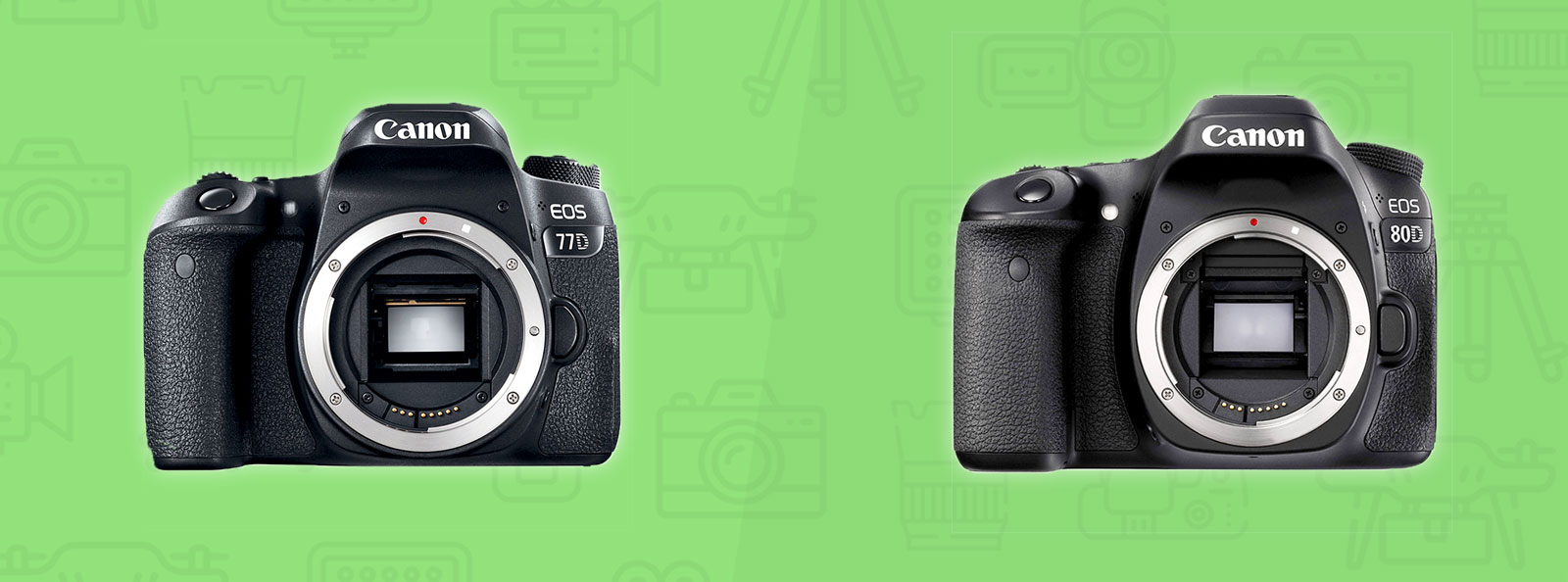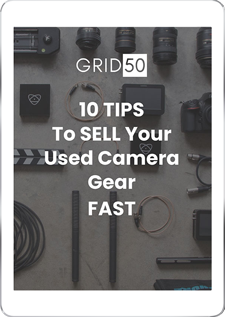Canon 77D vs 80D: The Complete Comparison
In this article, we compare the differences between the Canon 77D and 80D, so you can decide which camera is the best model for you.
Released just one year apart, and being relatively close in price, the many similarities between the Canon 77D and Canon 80D are to be expected. The two models share many of the same features such as megapixel size, LCD screen and articulation, video resolution, and more.
Yet, there are a few key differences between the cameras which may be important to you depending on what type of photography you shoot and the features you need. Features such as weatherproofing, continuous shooting speed, shutter speed, and body design separate the two cameras.
Whether you’re a photographer tacking the plunge and upgrading to the 77D or 80D from your entry-level camera or an intermediate to an advanced photographer looking for a highly capable camera at a mid-range price, this guide covers the key details and difference between both cameras so you can decide which model is right for you.
Check out the key details and our in-depth comparison to see which of these beginner cameras would be the best fit.
Key Details at a Glance:
The following chart shows the side by side specs of the Canon 77D and the Canon 80D:
| Canon 77D | Canon 80D | |
| Price | New: $750, Used: $630 (Body Only) | New: $900, Used: $800 (Body Only) |
| Release Date | 2/15/2017 | 2/18/2018 |
| Sensor | 24MP APS-C CMOS | 24MP APS-C CMOS |
| Viewfinder | Optical | Optical |
| Articulating LCD Screen | Yes | Yes |
| LCD Screen Size | 3” | 3’’ |
| Viewfinder Resolution | 1040k | 1040k |
| Lens Type | Canon EF/EF-S | Canon EF/EF-S |
| Continuous Shooting Speed | 6.0 fps | 7.0 fps |
| Video Resolution | 1920 x 1080 | 1920 x 1080 |
| Weather sealed | No | Yes |
| Image Stabilization | No | No |
| ISO Range | 100-25600 (expandable to 51200) | 100-16000 (expandable to 25600) |
| Low Light ISO | 971 | 1135 |
| Battery Life | 600 Shots | 960 Shots |
| Time-Lapse Recording | Yes | Yes |
| Touchscreen | Yes | Yes |
| Selfie Friendly LCD | Yes | Yes |
| Wireless Connection | Yes | Yes |
| Bluetooth Connection | Yes | No |
| Microphone Port | Yes | Yes |
| AE Bracketing | Yes | Yes |
| Smartphone Remote | Yes | Yes |
| Built-in Flash | Yes | Yes |
| External Flash | Yes | Yes |
| Lenses Available | 326 | 326 |
| Dimensions | 131x100x76mm | 139x105x79mm |
| Weight | 540g | 730g |
Detailed Comparison
Taking a look at the side-by-sides specs for these two cameras can help you get a quick overview of their differences, but it’s always helpful to dive deeper.
In this section, we’ll cover how these cameras compare on design, battery life, connectivity, weatherproofing, and pricing.
Design & Battery Life
One of the biggest differences between these two models is their size, weight, and battery life.
When it comes to body size, the Canon 80D is slightly larger coming in at 139x105x79mm vs. the 77D at 131x100x76mm.
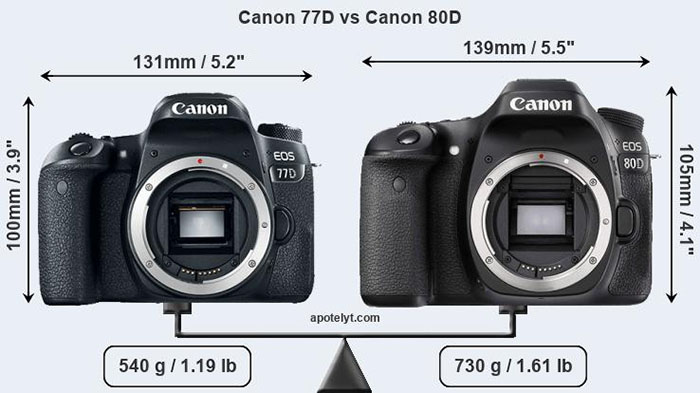
Image via Apotelyt
This is not a huge size difference but may bother those with smaller hands or for the photographer who is concerned about portability. The bigger differentiator when it comes to the design of these two cameras is the weight.
Despite being a year older, the Canon 77D weighs nearly 200g less than the 80D. The 77D weighs 540g while the 80D weighs 730g.
This added weight can take its toll on long shoots and/or anytime where you have your camera in your hand during the entire shoot.
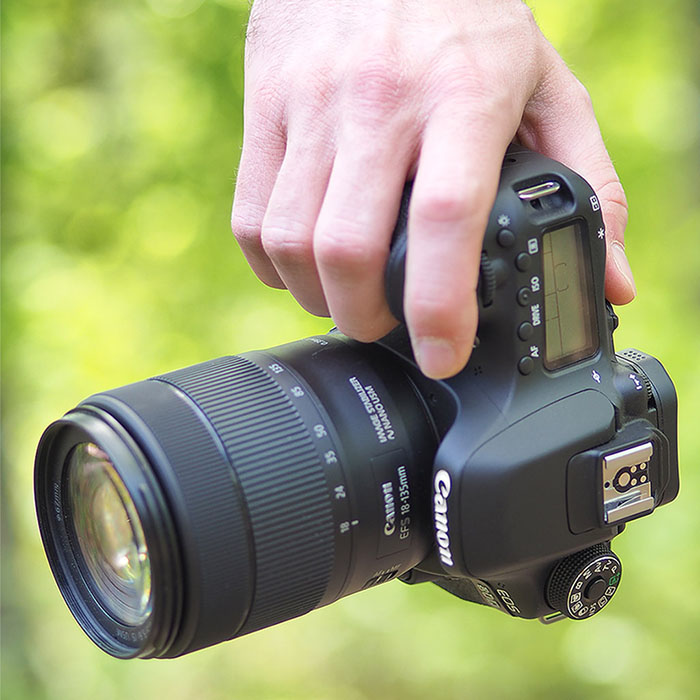
Image via Imaging Resource
Where the 80D does win out, though, is on battery life. The 80D can take an impressive 960 shots on one battery charge vs. just 600 shots on the 77D. While both cameras can shoot more on one battery than many cheaper DSLR models and even mirrorless models, the 80D is the clear winner when it comes to battery life.
So if you need a camera that will last a long time on one battery, and want to cut down on the number of batteries you need to bring to your next shoot, the 80D is the choice for you.
Continuous Shooting Speed & Shutter Speed
Another big differentiator between the 77D and 80D is the continuous shooting speeds on each of these cameras. Shooting at 7 fps, the Canon 80D is able to handle a full 1 fps more than the 77D at 6 fps.
This may not seem like a big difference to some, but for those photographers who are in sports or wildlife photography, that extra frame per second can mean the difference between capturing a key moment in crisp detail or missing it entirely. Wedding and event photographers will likely appreciate the shooting speed as well so they can make they capture a vital moment as clearly as possible.
To sweeten the pot, the 80D is also capable of shooting at shutter speeds up to 1/8000s whereas the 77D is only capable of shutter speeds up to 1/4000s.
For photographers who need a fast camera, the 80D is the clear winner.
Weatherproofing
For landscape and nature photographers, or just anyone who wants to be able to use their camera outside in wet and/or rainy conditions, the 80D will be the best choice between these two models.
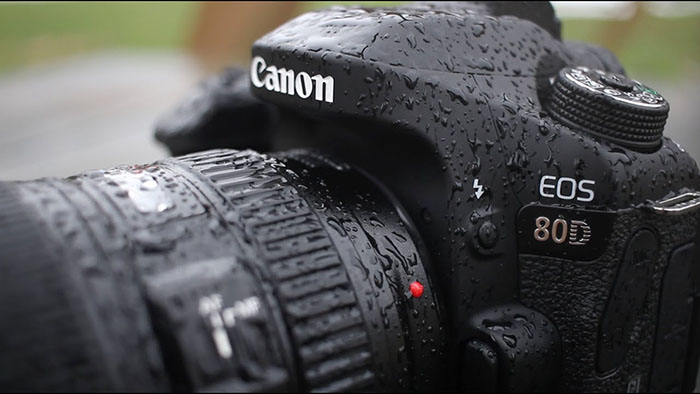
Image via TbonesTech
The Canon 80D camera body is weather-sealed, meaning it will be resistant to rain and wet conditions (not completely waterproof), while the 77D is not.
Connectivity
While both camera models are equipped with built-in wireless connectivity, oddly missing on the newer Canon 80D is Bluetooth connection. The older Canon 77D, does have Bluetooth, however.
So if you want the ability to use your camera with a Bluetooth device, go with the 77D.
Pricing
Being released in 2017, the Canon 77D can be hard to find new, but there many used options out there. If you’re considering buying used, the Canon 77D is definitely the winner on price.
A Canon 77D camera body can be found for as low as $500 to $550 (with the average about $630), whereas the 80D usually comes in at $650 to $700 at its lowest (with the average about $800).
If price is a concern, and you want to secure the cheapest camera possible between these two models, then the 77D is the best choice for you.
The Final Verdict
Ultimately, both of these two models, the Canon 77D and 80D are very similar cameras, which is to be expected being released not too far apart and relatively close in price. Both cameras have a touchscreen LCD that is 3” in size, full HD video recording (but no 4K), built-in flash, a microphone port, 24 megapixels, the list goes on.
The big differences are in the size and weight of these two cameras, Bluetooth connectivity, shooting speed, and battery life.
If you’re a sport, wedding, event, wildlife, or any other photographer who needs the fastest camera possible to capture critical moments, then the 80D is your best bet. While priced slightly higher than the 77D, the higher fps and shutter speed will provide you with the best tool to capture fast-moving objects. Additionally, the performance in battery life will ensure you don’t run out of juice mid-shoot.
However, if you’re concerned about price, require Bluetooth connectivity, or want the lightest, most compact camera between the two models, the 77D will be the camera for you. Its smaller design and weight will make carrying this camera easier on you throughout your shoots and easier to pack. Which will be nice, since you’ll save nearly $100 to $150 on this camera (when buying used), so it’ll offset the added weight in your wallet (metaphorically speaking of course :))
